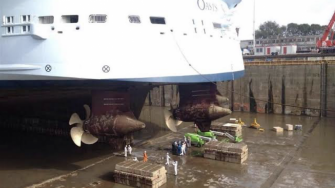Awash with issues - managing the infrastructure impacts of the new mega-ships
The UNSW Water Research Laboratory (WRL) is now equipped with one of the world’s first dedicated testing facilities to model propellor wash impacts from new super ships.
The UNSW Water Research Laboratory (WRL) is now equipped with one of the world’s first dedicated testing facilities to model propellor wash impacts from new super ships.

With the increasing size of ocean liners and cargo vessels, many newer and larger ships are equipped with their own systems for manoeuvring and berthing in confined areas - a role that was once performed by tugboats.
Azimuth and bow thrusters, essentially massive propellers, are fitted to the hull of these vessels to enable the ships to manoeuvre themselves in tight quarters.
Improvements in vessel capability have, however, created a range of new challenges for the ports at which they berth, as the powerful jets used to self-propel vessels may have devastating effects on structures that were not designed for jet impacts.
The huge propellers generate concentrated currents or “jets” of water moving at high speed, which in some instances can damage the infrastructure of the ports themselves. The fast moving and turbulent water from the jets can scour sediments and cause undermining of structures, or simply cause excess loads on structures.
Research leader Dr Francois Flocard, Principal Engineer at WRL says, "A majority of port infrastructure around the world was not designed to accommodate the massive forces that these new vessels can generate. At 100% power, a modern cruise ship can blast water jets with a diameter of nearly 3 m moving at 10 m /s on the quay at which it is berthing!"
Port operators are now left facing the decision of whether to restrict bow and stern thruster operations or to invest significantly in updating structural protection.
The UNSW Water Research Laboratory in the School of Civil and Environmental Engineering has recently opened a dedicated prop-wash facility for physical modelling the effects of ship side thruster forces on existing armoured berths and ports. This new facility consists of a 4m by 7m, 1.4m deep basin in which a model of the port infrastructure (often with a mobile bed included) and erosion protection solutions can be installed and tested. The basin is equipped with four submersible frequency-controlled power motor units and various sized propellers, which can simulate a wide range of vessel types.
Specialised monitoring equipment such as Acoustic Doppler Velocimeters (ADVs) allowing the measurement of 3D underwater velocities, submersible high-speed cameras, and 3D laser scanners are typically used for this complex type of experimental testing.
WRL researchers Dr Francois Flocard, Mathieu Deiber, Gabriella Lumiatti, Brett Miller, and Ben Modra have successfully delivered numerous major port studies at large scales ranging from 1:13.5 to 1:20. Froude testing at these scales is unique and ensures that turbulence and drag effects are well reproduced with a high Reynolds number. The scaling rules have ensured adequate turbulence based on coastal engineering scaling rules for armour mass and provide adequate resolution and accuracy for model measurements.
Brett Miller, Principal Engineer at WRL says, "WRL’s unique experimental facility will help expand engineering design knowledge on how to upgrade and protect port infrastructure subjected to these new class of self-propelled vessels."
While existing guidelines provide generally conservative analytical methods, physical modelling allows for a greater local understanding of each specific port. When an appropriately scaled model is used, the port design and operational restrictions can be balanced and optimised.
A full description of the physical modelling methods used, and research findings, will be presented by the WRL team at the upcoming Australasian Coasts & Ports 2021 Conference being held in Christchurch, 10 – 13 April 2022.
For further information contact:
Dr Francois Flocard | Principal Engineer | f.flocard@wrl.unsw.edu.au